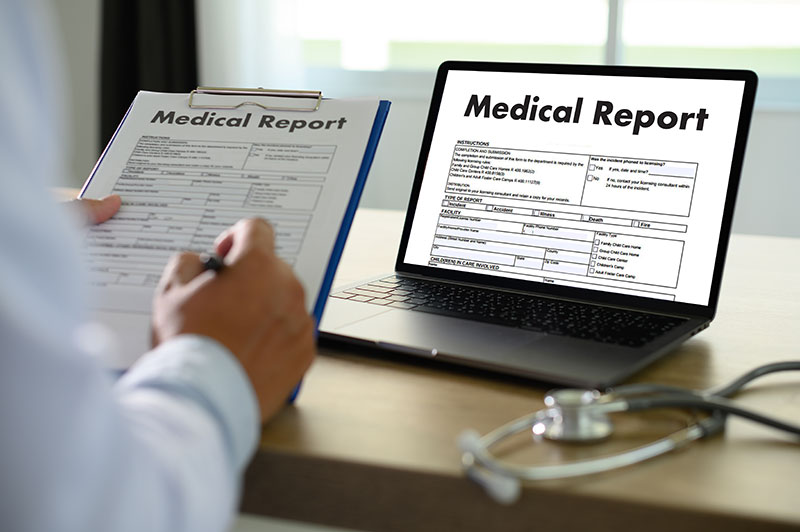Did you know that every year, healthcare systems around the world generate exabytes of patient data?
Yes, from clinic notes and radiology images to lab results and prescriptions, data is generated and shared. But when it comes to reviewing and interpreting that mountain of data, who does it more reliably, intelligently, and ethically? Human vs AI in medical record review: which one’s the better choice? These are the questions for which we’d be finding answers.
In one striking recent example, Microsoft’s AI Diagnostic Orchestrator reportedly diagnosed 85% of complex medical cases correctly, compared to the mere 20% for a cohort of 21 regular doctors handling the same challenging cases.
This staggering statistics gets us into asking: are we entering a moment when machines are truly going to surpass humans in medicine, or is the sensible path somewhere in between?
In this post, we compare and contrast humans and AI in the medical record review domain, explore hybrid models, assess limits and risks, and suggest when and how each “competitor” shines (or fails).
What Do We Mean by “Medical Record Review”?
Before getting into the debate of “who wins,” we need clarity on the scope itself. Medical record review broadly refers to the process of reading, analyzing, and extracting meaning from a patient’s health records: clinical notes, imaging reports, lab values, pathology reports, diagnostic tests, medications, and more. The typical tasks include:
- Data abstraction and summarization (pulling out key facts, timelines, and patterns)
- Coding, billing, and compliance checks
- Consistency checks and error detection (e.g. contradictory entries, missing data)
- Clinical interpretation and flagging anomalies
- Decision support and retrospective audit
Thus, the medical record review process touches on both structured data (labs, vitals) and unstructured narrative (physician notes, imaging impressions), and requires domain knowledge, reasoning, and context awareness.
When comparing human vs AI in this domain, it is important to evaluate them based on accuracy, efficiency, consistency, adaptability, and safety.
Strengths of the Human Expert
- Deep domain knowledge, context, nuance: A well-trained clinician/coder brings years of clinical reasoning, tacit knowledge, pattern recognition, and the ability to interpret ambiguous or contradictory information. Humans can understand nuances like subtleties in phrasing, irony, contextual hints, and clinical judgment in unusual cases.
- Flexibility, common sense, adaptive inference: Humans can identify and deal with rare cases, incomplete documentation, and unusual comorbidities by reasoning out likely explanations, sometimes even making leaps that are not strictly rule-based. They can ask clarifying questions, recall memories of similar cases, consult peer experts, or refer to external literature.
- Accountability, trust, ethical sensitivity: Humans are accountable for judgments, can explain (at least partially) their reasoning, and can incorporate non-quantitative ethical and social considerations (e.g. patient preferences, risk tolerance, legal implications). In contrast, AI “black boxes” often struggle to explain their reasoning in transparent ways acceptable to regulators or clinicians.
- Handling rare cases and exceptions: Some patients may have highly unusual histories, rare diseases, or atypical presentation. AI trained on general patterns may struggle there, while a human expert might catch the odd nuance.
However, humans also have well-known limitations: fatigue, inconsistency, inter-observer variability, bias, and slower throughput.
What Are the Strengths of AI in Medical Record Review?
- Speed and scalability: Once trained and deployed, AI’s capability of processing thousands of records in a matter of seconds/minutes is unprecedented when compared to human counterparts, especially when using AI in healthcare data review, systems show unprecedented scalability and consistency. This is particularly beneficial for large-scale audits, population-level reviews, and screening tasks.
- Consistency and mitigation of human error: AI never gets tired, distracted, or emotionally biased (at least in theory). It applies statistical models uniformly, which may reduce error variability across large volumes.
- Pattern recognition beyond human capabilities: AI systems, particularly deep learning models, can promptly spot subtle correlations across many dimensions (labs, imaging, timeline trends) that humans otherwise might miss. In radiology, pathology, and genomics, such models have already witnessed sensitivity improvements.
- Cost advantages in routine work: Over time, scaling AI for repetitive, well-defined tasks (e.g. coding validation, flagging inconsistent entries) can reduce costs per record review, especially when the marginal cost of human hours is high.
- Continuous improvement via learning: AI systems can improve over time as they are exposed to more data, feedback, and corrections; ideally trending toward higher accuracy and fewer false positives/negatives.
Despite all the above-mentioned advantages, AI has significant limitations as well, which we must carefully examine.
Human vs AI: Empirical Findings & Studies
What does the evidence say so far? The picture is nuanced: neither side dominates in all respects. Let’s take a deeper look:
- In diagnostic tasks, several studies show AI can match or outperform humans on narrow tasks. For instance, AI exceeded dermatologist performance in some skin disease classification tasks (1 % vs 65.8 %).
- In radiology image screening, AI systems have flagged subtle lesions and acted as second readers, though ultimately humans must often adjudicate.
- A meta-analysis of generative AI found a pooled accuracy of ~56.9 % in medical diagnostic tasks, reflecting that in broad, open-ended settings, AI still struggles.
- In a randomized vignette study, providing doctors with AI model suggestions plus explanations improved diagnostic accuracy from 0 % to 77.5 %.
These findings suggest no absolute winner, as the outcome depends heavily on task specificity, data quality, integration design, and human–machine interaction.
The stakes are high in the domain of medical record review: errors in abstraction, interpretation, or omission can lead to misdiagnoses, compliance violations, fraud, or harm.
Key Evaluation Dimensions: Who “Wins” Where?
Let’s compare humans and AI across several parameters relevant to medical record review.
| Parameter | Human Strengths | AI Strengths | Challenges / Weaknesses |
| Accuracy | Strong where context, ambiguity, nuance, rare cases are involved | High in well-defined, repetitive tasks; pattern detection | AI may hallucinate, misinterpret nuance, be brittle with new data; humans vary between reviewers |
| Speed / Throughput | Limited by fatigue, availability | Vastly superior for bulk review | Training, validation, error correction overheads |
| Consistency / Standardization | Variable across individuals, shifts | Uniform application of rules | AI can repeat systematic errors; humans may catch weird outliers |
| Interpretability / Explainability | Humans can articulate reasoning (though imperfectly) | Some models provide “saliency maps” or features, but often black box | Regulatory, legal, and ethical demands often require interpretability |
| Adaptability / Learning | Human experts can learn from edge cases, new knowledge, real-time feedback | AI can update with new data, but may require retraining and robust validation | Overfitting, drift, domain shift, adversarial data risk |
| Safety & Oversight | Humans can catch ethical, legal, and clinical risks escalate | AI may flag anomalies but lacks moral judgment | AI malfunction, “out-of-distribution” risk, lack of common sense |
| Cost / Scalability | High marginal cost for each additional reviewer | Once built, incremental cost is low and scalable | Upfront development and maintenance cost; need oversight |
| Edge / Rare Cases | Better at handling unusual or novel cases | Poorer in rare or underrepresented cases | AI suffers from training bias, data scarcity |
| Trust & Accountability | Easier to assign responsibility; human contact matters to patients | Rapid output and scalability but lower trust in many contexts | Trust in AI is still fragile, especially in healthcare |
From this table, we can figure out that AI tends to “win” in domains like volume, routine, consistency, cost-scaling tasks, while humans retain the edge in interpretation, accountability, nuance, rare events, and safety oversights.
Therefore, it’s misleading to picture this as a zero-sum contest. In practice, hybrid human AI record review models ensure speed, safety, and accountability
Hybrid Models: Best of Both Worlds
A growing consensus in medical AI research is that human–AI collaboration often outperforms either alone. The idea here is to allocate tasks optimally:
- AI as first-pass reviewer
- The AI scans and highlights records or segments with anomalies, inconsistencies, or high-risk features.
- For example: flagging conflicting medication entries, potential missing diagnoses, or dramatic lab jumps.
- Human experts for oversight, adjudication, and exceptions
- Review the AI’s flagged segments or “low confidence” records.
- Handle edge cases, ambiguous findings, or pathologies that AI struggles with.
- Feedback loop & continual model improvement
- Humans correct AI misjudgments, creating labeled data that improve model performance over time.
- Monitor AI error drift, bias, and adaptation to new clinical practices.
- Explainability & audit trails
- AI gives interpretable justifications or confidence scores.
- Human reviewers can trace, or override decisions as needed.
This is not hypothetical. In diagnostic studies, combining human and AI judgments improved performance beyond either alone.
In record review scenarios, this hybrid architecture offers the best tradeoff: speed, scale, safety and human oversight.
What Are the Challenges of AI Adoption in Medical Record Review?
Even though AI generally makes lives easier, it is not without certain challenges. Here are a few to consider:
- Data quality, bias, and generalizability
AI is only as good as its training data. If the data is biased (e.g. under-represent minorities, rare diseases, or non-standard documentation styles), the AI might misinterpret or mishandle real cases.
- Ethical, privacy, and security concerns
Medical data is highly sensitive. AI systems must guard against data leakage, adversarial attacks, and privacy breaches. Decisions influenced by AI must respect ethical principles and be auditable.
- Model interpretability and regulatory requirements
Medical and legal contexts often demand clarity in explanations (“why did the AI recommend X?”). Black-box models lacking transparency can raise problems for trust, liability, and auditing.
- Error cascade risk
If AI is integrated blindly without human checks, errors can compound. A misclassification early on might propagate downstream misinterpretations. That’s why human oversight is vital for accuracy.
- Overreliance and complacency
Because AI makes things easy, human reviewers may begin to overtrust AI outputs, thereby losing critical thinking or failing to double-check. Studies in radiology show that AI assistance can sometimes harm performance in less experienced users.
- Cost, maintenance, and validation overhead
Developing, validating, and maintaining AI models in healthcare is expensive. Regular retraining, monitoring, and safety audits are needed. Upgrades may require revalidation, regulatory reviews, and testing.
Final Thoughts
When it comes to medical record review, the question is not “who wins: human or AI?” but “how can we design a partnership, so both win together?” Humans bring nuance, accountability, and interpretive skills to the table, while AI brings speed, consistency, and scale. And, as mentioned above, hybrid models tend to deliver the best outcomes.
That said, deploying such a system is not trivial, as one must invest in data quality, validation, transparency, oversight, and appropriate workflow design. But for organizations willing to do so, the payoff is significant: faster reviews, fewer errors, lower cost, and better compliance – all under the umbrella of responsible governance.
Stand Out in Compliance and Quality
We bring rigorous QC, domain experts, and AI-augmented efficiency to your fingertips.




